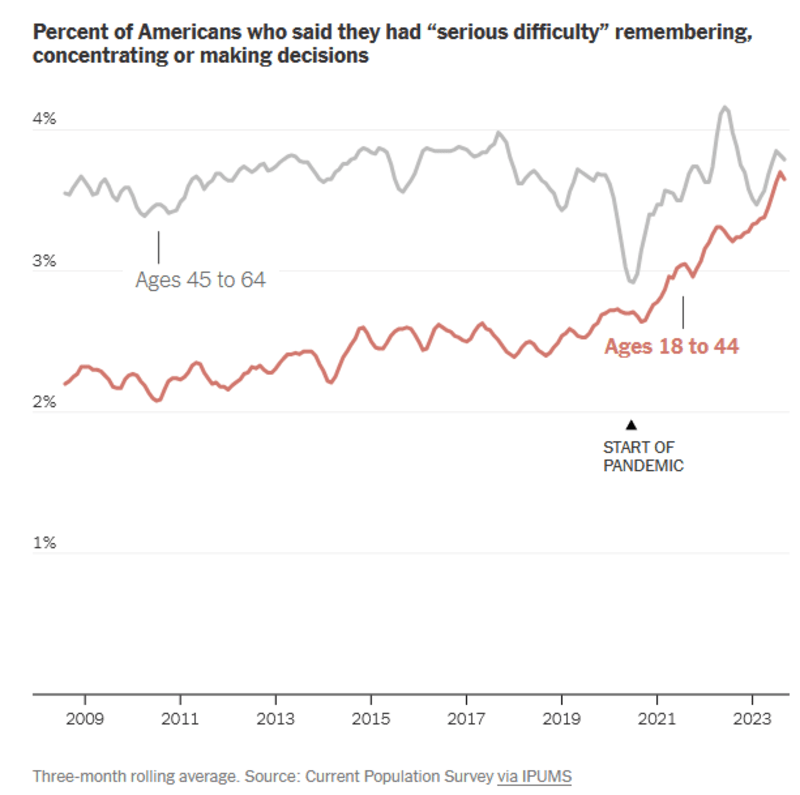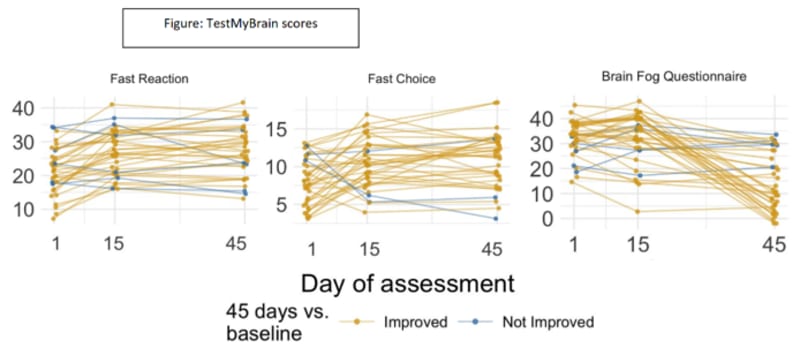Long COVID is estimated to affect more than 17 million Americans. The UK has a BioBank program that collects massive amounts of data on post COVID cognitive dysfunction. Their data suggests that patients with even mild COVID had a greater decline in executive function, notably in their ability to perform complex tasks as reflected in a greater loss of gray matter on M R I. Note that only 4 percent of the population with post covid cognitive decline had been hospitalized for COVID.
A 2024 report (Fig 1) on people with difficulty in remembering and concentrating or making decisions saw a significant increase in younger people. This is a major concern as older people may just say “I’m just getting old and that’s why I can’t remember”, while it’s actually the effects of COVID. It has been reported that COVID causes a 3 to 6 point decrease in I Q. For young people with loss of executive function, it may not affect who they are but might affect who they could have been.
This suggests that the number of people in the US that might have been affected might climb to more than 100 million people:
COVID is known to inflame blood vessels. The inflamed vessels in the brain narrow and reduce blood flow. Carbon Dioxide in the blood is a potent controller of cerebral blood flow and oxygen delivery to the brain.
We developed a novel treatment application using our FDA cleared Hi-OxSR sequential rebreathing mask that increases inhaled CO2. It doesn’t require an external source of CO2 gas and has patients rebreathing a portion of their exhaled CO2 to increase cerebral blood flow (20-50%), which provides more oxygen to the brain. It uses a very low flow oxygen source (e.g., a oxygen concentrator) and the Hi-OxSR, which captures the exhaled CO2 and uses a serial of silicone valves to enable the patient to inhale the 93-98% oxygen, sequentially followed by their exhaled CO2 (Figure 2). Treatments for 30 minutes twice a day for 14 or 28 days have been tested in patients with long COVID.
A feasibility study in 5 volunteers with long COVID provided a positive signal, followed by a pilot trial in 36 subjects using memory and executive function testing and a brain fog questionnaire for quality of life. The subjects self-treated at home for 14 days and were tested at baseline, Day 15, and 30 days after completion of treatment. The results (Fig 3) demonstrated a significant improvement in 75-80% of the subjects and at Day 45 there was further improvement in some subjects (higher numbers are better). The Brain Fog QoL survey showed no improvement at completion of the treatment, but a clearly significant improvement 30 days later (lower numbers are better). While has been prescribed for treatment of some people in the US, we are starting a randomized, placebo controlled, dose ranging trial in Canada.
Like this entry?
-
About the Entrant
- Name:Alex Stenzler
- Type of entry:individual
- Software used for this entry:SolidWorks
- Patent status:pending









